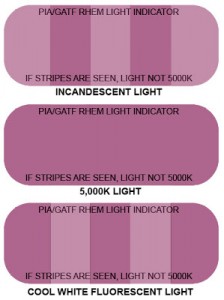Metamerism is the phenomenon where two different colour samples appear to match under one set of lighting conditions, but not under different lighting. The two colours are called metamers. For example, did you ever get dressed in the morning and everything matched great in the mirror, only to step outside into the sunlight and glance at your reflection noticing a huge shift in colour hue? This is because colours can change when the light source changes.

How metameric failure impacts print production
There are four types of metameric failure commonly encountered in print production.
Sample metameric failure This is the most common cause of colour matching problems and typically manifests itself when presswork matches the proof in the light booth at press but no longer match under the lighting conditions where the presswork will normally be used, e.g. a Point of Purchase display in a store, or brochure at a trade show event. Sample metameric failure can also happen if two prints using very different technologies – such as offset print versus silkscreen print – are compared under different lighting conditions.
Observer metameric failure Different observers, including people and instruments, can perceive colour differently. This can be due to a person’s colour vision or an instrument’s geometry, which can cause a difference in colour measurement. As a result, two spectrally dissimilar colour surfaces may produce a colour match for one person but fail to match when viewed by another person.
Field-size metameric failure In this case, colours that match when viewed as very small, centrally fixated areas may appear different when presented as large colour areas. This is the reason why colour painted on a wall may appear different than the paint chip used to select the colour even though they match when the chip is placed on the wall. In print production field-size metameric failure typically occurs when small PANTONE swatch book samples are used to specify a PANTONE spot colour that will cover a large press sheet area.
Geometric metameric failure This can occur when other aspects of appearance, other than colour, cause materials to match under one set of viewing conditions, but not under others. It can be caused by differences in gloss, texture, transparency, and other appearance factors. This effect is most often seen when using metallic inks or paper, and specialty ink coatings or papers.
Purpose Of The PIA/GATF Light Indicator
A PIA/GATF light indicator makes it easy to determine if your viewing conditions are right for accurate colour evaluation, specification and matching. The industry standard light source is referred to as “D50” or “D65” (5,000° Kelvin North America, 6,500° K Europe).

Stripes appearing in the RHEM label indicate the lighting conditions and therefore whether a colour evaluation can be made.
The Light Indicator is a simple tool that will identify many common nonstandard light sources. It will not show small colour variations between light sources, such as the effects of lamp aging on 5000° K fluorescent lamps or deficiencies in light intensity.
View the Light Indicator under a standard 5000° K light source and no stripes will be seen. Then, view it under incandescent, cool, and warm white fluorescent light sources and see the stripes appear.
Stripes appearing in the sticker indicate the lighting conditions and therefore whether a colour evaluation can be made.
We are print experts — so you don’t have to be. For any questions regarding colour or colour matching with your next print project, contact any of our Print Made Easy sales representatives today.
Source: http://the-print-guide.blogspot.ca/2010/05/issue-of-metamerism-in-print-production.html
Find more like this: Featured, Technologies




